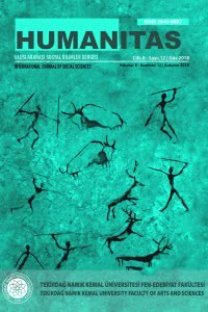FROM ‘HOWLING WILDERNESS’ TO ‘HOLY WILDERNESS’-‘ULUYAN YABAN’DAN ‘ULU YABAN’A
Doğa kavramı, doğa bilimlerinden sosyal bilimlere, felsefeden sanat ve edebiyata uzanan farklı çalışma alanları ve bilimsel araştırmalar için her zaman bir odak noktası olmuştur. Öyle ki doğa, Kuzey Amerika’nın ilk sakinleri yerlilerden başlayarak koloniciler, Püritenler, deistler, bilim insanları, gizli romantikler, romantikler, transandantalistler, realistler ve natüralistler ile devam eden birçok araştırmacı, düşünür ve edebi figür için cezbedici olmuştur. Bu makale farklı dini, kültürel, bilimsel ve edebi bakış açılarını inceleyerek Kuzey Amerika’daki Püritenlerden transandantalistlere kadar uzanan doğanın kavramsallaştırılma sürecini tartışmaktadır. Bu bakış açıları doğa kavramlarının oluşumuna katkıda bulunmuştur ve böylelikle doğanın farklı anlamları ve algılanış biçimleri insanların belirli dönemlerdeki önyargıları ve hayal güçlerine bağlı olarak ortaya çıkmıştır. Her dönemdeki egemen bakış açısı, doğanın kavramsallaştırılma sürecinde önemli rol oynamıştır. Bu yazıda böyle bir evrimsel süreç, belirli dönemlere özgü metinler ışığında ele alınarak ekoeleştirel bakış açısıyla tartışılmaya çalışılacaktır
Anahtar Kelimeler:
Doğa, Edebiyat, Ekoeleştiri, Amerika
FROM ‘HOWLING WILDERNESS’ TO ‘HOLY WILDERNESS’
The concept of Nature has always been a focal subject in different fields of study and scientific researches, ranging from natural sciences to social ones and, from philosophy to arts and literature. Within this framework, Nature in North America has thus far attracted numerous researchers, thinkers, and literary figures starting with the original settlers of the continent, indigenous (native) peoples, and continuing with colonists, Puritans, deists, scientists, dark romantics, romantics, transcendentalists, realists, naturalists etc... In this article, the subject matter is confined to the conceptual analysis of Nature from early Puritans to transcendentalists in North America. This article discusses a conceptualization process of nature from the early Puritans to the transcendentalists in North America by examining various religious, cultural, scientific, and literary perspectives. These perspectives helped the formations of the concepts of nature thus different senses and perceptions of nature emerged in certain periods according to the preconceived opinions and imaginations of people. Each dominant perspective in each period has a significant role in this conceptualization process of Nature. This kind of evolutionary process is tried to be discussed through examining specific texts which clearly represent these certain periods and by making use of ecocriticism.
Keywords:
Nature, Literature, Ecocriticsim, America,
___
- Branch, M. (1996). Indexing American Possibilities: the Natural History Writing of Bartram, Wilson, and Audubon. In C. Glotfelty & H. Fromm (Eds.), The ecocriticism reader: landmarks in literary ecology (pp. 282–302). Athens: University of Georgia Press.
- Brown, C. B. (1973). Edgar Huntly or Memoirs of a Sleepwalker. (D. Stineback, Ed.). New Haven, CT.: The New College and University Press, Inc.
- Buell, L. (1995). The Environmental Imagination: Thoreau, Nature Writing, and the Formation of American Culture. Cambridge, Massachusetts: The Belknap Press of Harvard University Press.
- Buell, L. (2005). The Future of Environmental Criticism: Environmental Crisis and Literary Imagination. Malden, MA: Blackwell Pub.
- Danforth, S. (2006). A Brief Recognition of New-Englands Errand into the Wilderness: An Online Electronic Text Edition. (P. Royster, Ed.). Faculty Publications, UNL Libraries. Retrieved from http://works.bepress.com/paul_royster/5
- Edwards, J. (1962). Jonathan Edwards : Representative Selections, with Introduction, Bibliography, and Notes. (C. H. Faust & T. H. Johnson, Eds.). New York: Hill and Wang.
- Emerson, R. W. (1950). The Selected Writings of Ralph Waldo Emerson. (B. Atkinson, Ed.). New York: Random House, Inc.
- Gatta, J. (2004). Making Nature Sacred: Literature, Religion, and Environment in America From the Puritans to the Present. New York: Oxford University Press.
- Irving, W. (1835). A Tour on the Prairies. London: A Spottiswoode.
- Kern, R. (2003). Ecocriticism: What Is It Good For? In The ISLE Reader: Ecocriticsm, 1993-2003 (pp. 258–281). Athens and London: The University of Georgia Press.
- Nelson, B. (2000). The wild and the domestic: animal representation, ecocriticism, and western American literature. Reno: University of Nevada Press.
- Paul, S. (2001). on Thoreau, The Maine Woods, and the Problem of Ktaadn. In D. Mazel (Ed.), A Century of Early Ecocriticism (pp. 329–340). Athens and London: The University of Georgia Press.
- Regis, P. (1999). Describing Early America: Bartram, Jefferson, Crevecoeur, and the influence of Natural History. Philedelphia: University of Pennsylvania Press.
- Sanders, S. R. (1996). Speaking a Word for Nature. In The Ecocriticism Reader: Landmarks in Literary Ecology (pp. 182–195). Athens and London: The University of Georgia Press.
- Thoreau, H. D. (2004). Walden, or, Life in the woods ; and, On the duty of civil disobedience. New York: Pocket Books.
- ISSN: 2147-088X
- Yayın Aralığı: Yılda 2 Sayı
- Başlangıç: 2013
- Yayıncı: Namık Kemal Üniversitesi
Sayıdaki Diğer Makaleler
ACQUISITION DU SUBJONCTIF PAR LES ÉTUDIANTS TURCS
ORTAÇAĞ TÜRK-İSLÂM DEVLETLERİNDE HÜKÜMDARIN ADALET SEMBOLÜ: Dîvânü’l-Mezâlim
YAŞAYAN KENTSEL MEKANLARIN YARATIMI
MICHAL SOKOLNICKI’NIN “ANKARA GÜNLÜĞÜ”
Kültürel Unsurların Çevirisi ve Çeviri Stratejileri
Muhterem Şebnem ENSARİ, Hazal K: ALAY
GEORGE ELIOT’UN MIDDLEMARCH’I: VİKTORYEN DÖNEMİ ROMANINDA REFORM VE KALKINMA TUTKUSU
